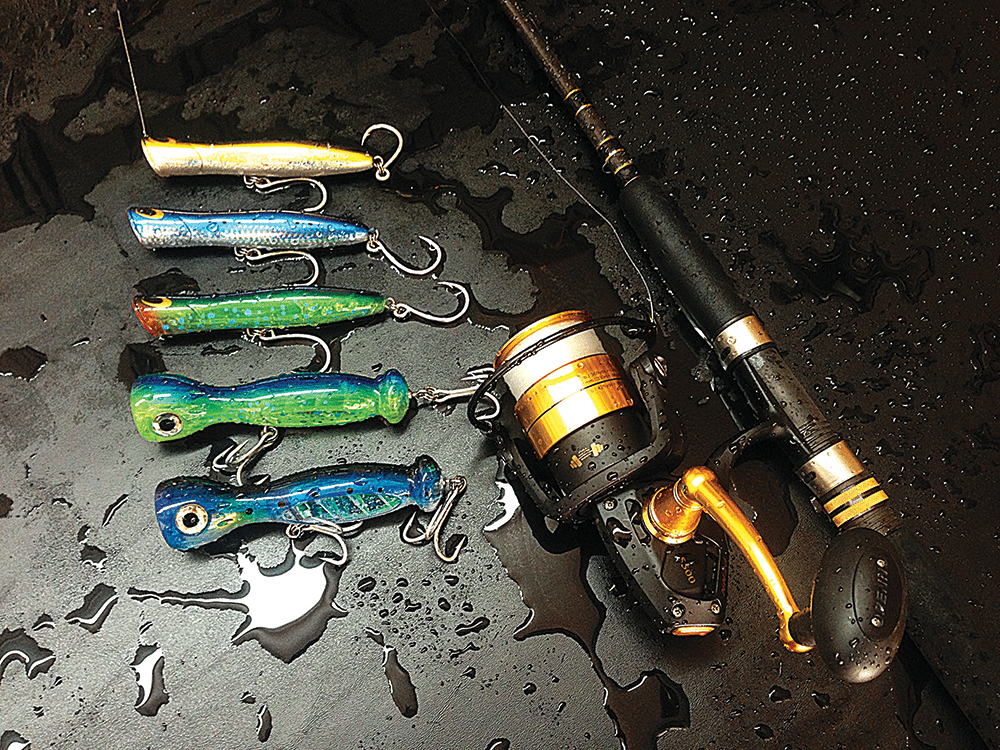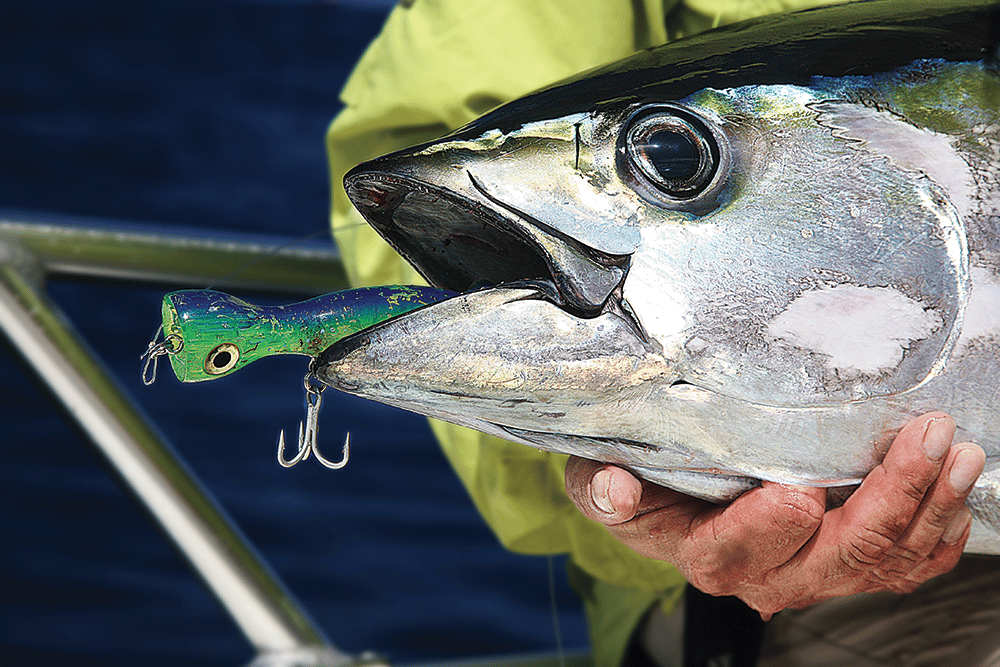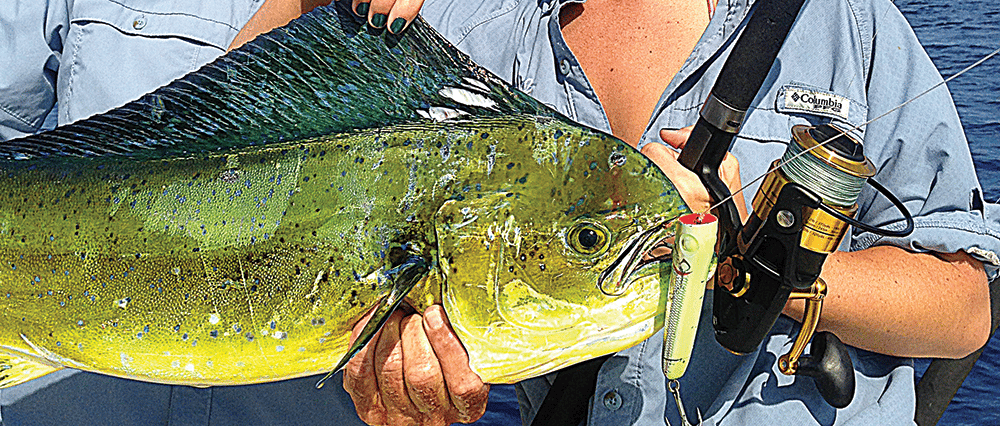It was among the wildest aerial displays by a dolphin I’d ever seen: A totally green fish — hooked on a chugging plug that Carl Grassi pitched alongside a floating board — charged toward the boat, rocketed six feet into the air and cleared the entire cockpit. I cowered beneath the treble hooks that soared overhead at high speed.

As the fish landed back in the water, I wondered if Grassi could get tight again before it threw the plug. He did, and we iced down the dolphin several minutes later.

Loud Hail
In the visually oriented world of topwater-plug fishing, inshore species are customarily the target, when they’re blitzing baits, roaming grass beds, or lurking beneath docks and heavy shoreline vegetation. Yet, it’s just as deadly a technique offshore, albeit less practiced.
Chugger-style plugs offer big advantages in certain situations. Compared with topwater lures with rounded heads — which lend a darting, walk-the-dog action with minimal splash — a chugger produces a tighter, in-line action. Furthermore, that concave head makes a chugger dig in, so it’s less prone to large fish, such as tarpon, bull reds or tunas, pushing it out of the strike zone during their attack. The distinguishing differences also include their highly audible distress vibrations and splashing. They’re simply hell on curious fish.
Recently, a friend and I drifted the grass beds in the Florida Keys backcountry, pitching walk-the-dog-style topwaters for seatrout. We scored a fish or two before my friend converted to a small chugger and began rallying the trout. The bite was so solid that I had to switch over to get noticed. Seatrout are attracted to sound, and on that particular morning, they showed a marked preference for a deeper, more emphatic vibration. It was a subtle difference to us, but a huge one for the trout.
Pick a Winner
At times, undersize or oversize chuggers — compared with the local forage — do the trick. However, consistent success generally comes by matching the size of the plug to the baitfish most abundant in the area. The philosophy of using brighter plugs on overcast days and darker colors on bright days for the silhouette effect does indeed have merit, but I prefer mimicking the color of the local bait most of the time — we could be trying to fool fish on a selective feed. Yet, when strikes are slow to come, I experiment by switching to a smaller or larger plug and altering the retrieve.
Surroundings should also influence your plug selection or modifications. For example, when pitching a stock treble-hook plug near treacherous structure, where a fish must be muscled away with heavy line (30- to 50-pound braid), will the stock hooks handle the pressure, or will they straighten? If there’s a risk, upgrade to a plug with extra-strong trebles or single hooks, or swap out the stock hooks on your plug of choice. Incidentally, single hooks prove easier and safer when releasing fish.

Where’s the Action
Dialing in an alluring action often requires observing what is happening within the environment. When fish are feeding on bait at the surface, imitate an injured baitfish fleeing from the carnage, matching its speed and frantic action. Casting over smaller baitfish, slight chugging with minimal push of water appears more natural to predators, as opposed to more aggressive, deep chugging that results in excessive noise and splash.
The species sought also should dictate the retrieve. Bluefish, jack crevalles, mackerel and barracuda respond best to quick retrieves, so keep the plug coming in rapidly, imparting a chug on every other turn of the reel handle. If you get followers, do not slow or stop the plug. That allows the fish to confirm it’s a fake. Instead, remove the lure from the water and immediately pitch it far out; the fish should pick up on the chugging and charge it, perhaps fearing competition from another fish. The opposite holds true with fish like larger striped bass, snook, tarpon and redfish, especially those around docks, jetties and similar cover. Try pitching up tide or up-current, slowly chugging the lure along the structure as if it were an injured bait carried by the current. Ditto along shadow lines at night. This can prove a potent retrieve when there isn’t an abundance of bait or a feeding blitz in progress.

Tease a Strike
Chuggers are awesome on offshore fish. I carry at least one rod rigged with a chugger every time I head out, especially when searching for dolphin. And they’re great for surface feeding tunas, as well.
Dolphin are curious fish, similar to cobia and amberjack over shallow wrecks. When we approach a board or a patch of weeds, we’re set to present a live bait or fresh ballyhoo on a 20-pound-class spinner to a large dolphin, or a chugging plug to school fish. Even when a floating object or weed patch harbored no fish, I’ve seen the chugging plug call them in after only a few casts.
For dolphin and tuna, my favorite chuggers are the 5-inch Williamson Jet Popper and the new Popper Pro 130. The latter comes with two single, extra-strong hooks (no trebles to deal with), so you can pressure fish without worrying about straightening them. One more tip: The three top chugger colors for dolphin and tuna are, in my opinion, blue-and-silver (flying fish pattern), green-and-yellow (mimics a juvenile dolphin, forage for tuna and big dolphin), and gold-and-silver (imitates bar jacks and banded rudderfish, which dolphin and tuna seek under weed lines and other floating debris).

Dolphin, cobia and amberjack can be teased up to the boat using chugging plugs if they’re in the area. Again, with any followers, keep that chugger coming to the boat. If you run out of real estate and the fish isn’t committing, speed up the retrieve and pull the lure from the water. Shoot it back out and repeat until you get a strike. With amberjack over shallow wrecks, make quick figure-eight chugging patterns alongside the boat. This often pushes a fish over the edge.
Finally, use a loop knot when joining leader to lure to avoid restricting a chugger’s action. This loop allows the lure greater latitude to move about during the retrieve.
Chuggers have always been hot inshore. Upgrade your color selection and lure size, rigging and retrieves with offshore demands in mind and pitching a no-hitter will be a rare day indeed.









